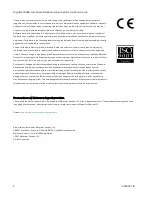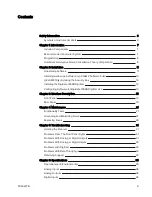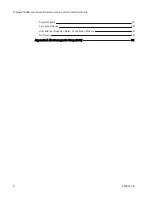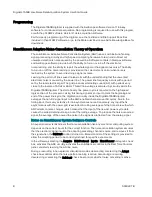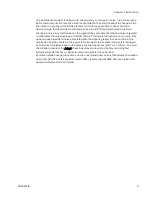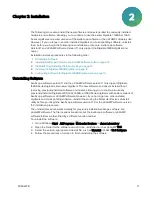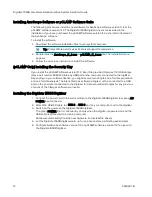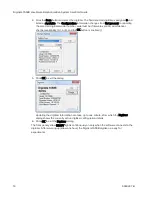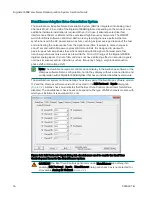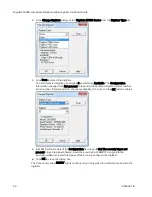
Digidata 1550B Low-Noise Data Acquisition System User Start Guide
8
5040237 B
Programming
The Digidata 1550B digitizer is supplied with the AxoScope software Version 11 turnkey
software for continuous data acquisition. No programming is required for use with this program,
or with the pCLAMP software Version 11 data acquisition software.
For third
‐
party programming of the digitizer, see the Test Bed and File Support Pack files
included in thepCLAMP software, or go to the Molecular Devices website Knowledge Base for
downloads.
HumSilencer Adaptive Noise Cancellation Theory of Operation
The HumSilencer Adaptive Noise Cancellation System (ANC) uses a combination of analog
signal
‐
processing circuitry and high-speed computing hardware to learn and subtract out
unwanted electronic noise caused by the power line. Software controls in Clampex software
and AxoScope software provide both the ability to turn on or turn off the electronic
noise-learning, and the ability to report the whole signal or the signal-minus
‐
noise. The ability
to turn on or off the noise learning is provided so the scientist can control when noise is
learned by the system to avoid learning a signal as noise.
Learning the pattern of line-caused noise starts with the understanding that the unwanted
electronic noise is caused by the power line. The power line
‐
frequency occurs with a period
set by the local electrical grid. The grid produces alternating current (AC), with periods very
close to the inverse of 50 Hz or 60 Hz. This AC line-voltage is sampled by circuitry inside the
Digidata 1550B digitizer. The start of every line power
‐
cycle is reported to the high-speed
logic section of the processor. Using this timing signal as an input to mark the beginning and
end of the power line-cycle, the digitization circuitry inside the Digidata 1550B digitizer
averages the non-DC signal input to the ANC-enabled channels over 50 cycles. Due to the
timing input, this is very selective for line-synchronous noise. Conversely, any input that is
asynchronous with the power grid is excluded. A rolling average sets the time scale with which
ANC adapts to noise changes, which means that the input of the newest power-cycle data
causes the oldest data input to age out of the rolling average. To produce the noise-canceled
signal, the average of the power-line noise in the signal is subtracted from the analog signal.
Notes on HumSilencer System Software Controls
An experienced scientist knows that noise cancellation, like any electronic computing system,
depends on the correct inputs for the correct function. The noise cancellation system assumes
that the electronic signal input to the adapting cancelling channel is noise, and removes it from
the signal when the Subtract control is turned on. Manual control of the settings is provided to
allow the adapting period to be correctly defined for specific experiments.
In the software, selecting the Acquire > Edit Protocol > Inputs > HumSilencer dialog tab check
box, activates the ANC circuitry, activates the HumSilencer controls in the Real Time Controls
panel, and starts learning the AC-line noise.
During a recording, in non-episodic stimulation modes, deselecting or selecting the Adapt
check box controls when the noise-pattern learning is active. Also during a recording,
deselecting or selecting the Subtract check box controls whether noise cancelling is active.


